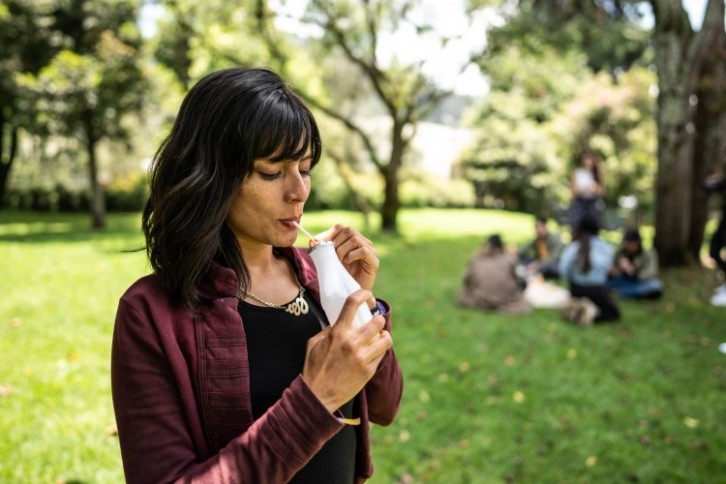[ad_1]
International client analysis carried out by GlobalData for ingredient provider IFF has make clear the most recent market and sensorial traits in dairy, with extra useful and environmental advantages and verifiable label claims being a key driver in buying choices.
GlobalData surveyed 21,000 respondents from 42 nations throughout Western and Japanese Europe, North America, Central and South America, Asia-Pacific, the Center East and Africa to determine overarching traits, akin to well being and wellness, affordability and added worth, in addition to drivers in product classes akin to drinks, desserts, ice cream and plant-based.
One key takeaway is that meals inflation has did not drive shoppers away from dairy, with most world consumers indicating they’d fairly pay the next worth than accept average-quality merchandise.
“Dairy has been one of many classes worst hit by inflation, with worth CAGR outstripping quantity CAGR, and this has been extra pronounced in subcategories akin to milk, butter and spreadable fat,” Richard Neish, head of world futures, client intelligence, at IFF, instructed us. “It have to be mentioned that almost all of world shoppers are at the moment unwilling to sacrifice high quality within the face of excessive costs, with 52% preferring to pay extra for dairy to make sure high quality isn’t compromised, and 63% beginning to purchase, persevering with to purchase, or extra ceaselessly shopping for costly or luxurious dairy manufacturers in This fall 2023.”
Searching for ‘worth with values’ in non-public label
Regardless of this, there’s no escaping the truth that 35% of the shoppers surveyed did swap to personal label merchandise in a bid to trim their dairy spend, he added. “Consequently, gross sales of personal label merchandise have elevated considerably, notably in Europe, as they’re perceived as providing larger affordability and comparable high quality to branded dairy,” he defined. “This can be because of shoppers believing that manufacturers are profiteering through the use of macroeconomic pressures as an excuse to disproportionately elevate costs – also referred to as ‘greedflation’.”
“Immediately’s savvy consumers are more and more looking for merchandise that supply “worth with values” – affordability coupled with high quality, security, ethics, sustainability, and a craving for simplicity in what seems like an more and more chaotic world.”
Manufacturers can attraction to budget-conscious shoppers by balancing their wants towards their values. “This may be achieved by constructing in extra worth akin to well being, moral or sustainability advantages, akin to by including probiotics, or through the use of higher-welfare or regionally sourced milk,” Neish defined.

“Moreover, time-poor shoppers put a premium on merchandise that may assist them dwell their on a regular basis lives extra effectively and successfully. For many who prize wholesome comfort, versatile merchandise that may be consumed on the go as ‘top-up’ vitamin will attraction.”
Demand can be rising for snack-sized dairy merchandise that supply larger dietary worth, together with low-fat cheeses, gut-healthy yogurts and useful dairy drinks, the analysis exhibits. In style traits recognized within the survey embody low-fat cheese, gut-friendly yogurts and useful dairy drinks.
Ambient dairy innovation can be one to look at, in accordance with the analysis, with IFF stating that there’s a possibility for shelf-stable merchandise with added well being advantages, akin to probiotics.
Placing a optimistic spin on ‘shrinkflation’
Moreover including worth by formulation, manufacturers can entice consumers to premium ranges by adjusting pack sizes. However with shoppers weary of ‘shrinkflation’ – the observe of shrinking the pack measurement whereas preserving the product’s worth the identical or larger – this technique must be rigorously executed, mentioned Neish. The excellent news is, there’s urge for food for smaller packs that stability worth with high quality.
“Shopper analysis exhibits that in 2023, youthful cohorts – and Era Z specifically – have been extra inclined to decide on smaller dairy pack sizes,” Neish instructed us.
“Busy, typically single existence are related to smaller, convenience-led serving sizes that reduce the chance of waste. On the similar time, the usually tighter budgets of youthful shoppers could deter them from buying bigger, high-priced packs. This gives an actual alternative for dairy manufacturers to focus on youthful shoppers with handy, smaller-sized merchandise.”
“Nonetheless, if manufacturers select to spice up affordability by shrinking pack sizes, they need to clearly talk this optimistic worth spin to shoppers, or in any other case threat being accused of ‘skimpflation’ techniques.”
From indulgence to wholesome residing and experimentation
With 50% of world shoppers prepared to reward themselves with pleasurable experiences and thru meals greater than they did pre-pandemic, there’s a possibility in balancing indulgence with well being and wellness. Sugar discount performs a key half right here, as Neish defined. “Probably the most influential megatrend throughout the meals and beverage house for the reason that pandemic has been well being and wellness, and it’ll proceed to dominate the dairy sector in 2024,” he mentioned.
“Sugar discount performs an element on this, with shoppers more and more scrutinizing sugar content material and displaying an urge for food for lower-sugar merchandise. Analysis exhibits that 72% of shoppers try to scale back or remove sugar from their diets, whereas 32% outline wholesome meals as being low in sugar.”
And but, in well-liked classes akin to dairy desserts and ice cream, it’s all about indulgence. “Dairy desserts are very a lot about indulgence, with shoppers demonstrating a robust want for sensory innovation whereas additionally having fun with conventional, nostalgia-inducing merchandise,” Neish mentioned. “This offers manufacturers a possibility to discover and innovate with traditional and novel flavors, and to create thrilling textural/multi-textural experiences to interact shoppers. Restricted editions and co-branding even have attraction and permit manufacturers to push boundaries.”
For many shoppers, ice cream is an indulgent consolation meals the place style stays king, he added. Conventional flavors are favourite for all client demographics, the analysis confirmed, however in the case of uncommon and new, stylish flavors, these are most frequently the choose of youthful cohots, notably Gen Z and Millennials.
“Whereas most prospects nonetheless favor conventional dairy flavors, Era Z and Millennials are notably eager to expertise new and strange choices, with their decisions extra influenced by social media than older cohorts,” Neish mentioned. “Inside this class, balancing indulgence, innovation and worth for cash is vital.”
Whereas social media platforms like TikTok are efficient in permitting dairy manufacturers to reveal the usage of easy elements in novel and thrilling methods, it’s dwelling cooking which stays the primary automobile for experimentation, the analysis prompt. When requested what conditions encourage them to attempt new flavors in meals, a median of 52% amongst Gen Z, Gen Z, Boomers and Millennials mentioned ‘cooking at dwelling’. This was adopted by ‘visiting a distinct nation’ (40%) and ‘buying from a retail outlet’ (36%).
Gaining belief by clear label claims
With accountable consumption a serious driver for buying choices, the analysis recognized that some shoppers doubt manufacturers’ honesty in the case of their sustainability credentials. In accordance with the survey, whereas 64% of world consumers thought that data shared by manufacturers is ‘usually dependable’, 69% ‘considerably’ or ‘strongly’ agreed that huge manufacturers declare to be extra eco-friendly than they really are.
Nearly one in three consumers (32%) thought that small or impartial manufacturers have been probably the most reliable when it got here to their moral, social and environmental claims, in comparison with 15% backing non-public label and 24% – multi-nationals.
Dairy alternate options are additionally struggling a disaster of client belief, with consumers doubting the optimistic impression of switching away from dairy.
“Whereas dairy has just lately confronted scrutiny as media protection has introduced criticism of animal agriculture into the mainstream, shoppers are additionally catching up with the fact that not all dairy alternate options are as “inexperienced” as they initially appeared,” Neish defined. “As a substitute, they’re reassessing the validity of well being and sustainability claims round, for instance, plant-based milk, which is now seeing a major slowdown in market progress.”
“For each dairy and alt-dairy producers, it’s important to be clear and correct about their environmental impacts, moral credentials and sustainability commitments, particularly within the face of an more and more strict regulatory setting that’s placing claims below larger scrutiny than ever earlier than.”
So, what ought to manufacturers be doing?
In an age of synthetic intelligence (AI) and ever-evolving social and client traits, constructing an emotional reference to the patron can enhance loyalty and repeat purchases, the examine suggests. “Dairy manufacturers can have interaction with shoppers to drive “worth with values” by story-telling – highlighting genuine environmental, moral and social credentials that replicate shoppers’ considerations and values,” Neish instructed us.
“As an on a regular basis important, dairy has not at all times prioritized such private engagement with the patron, however that is altering.”
“Era Z’s rising affect means dairy firms are realizing the necessity to construct advertising and marketing methods that inform extra complicated, significant tales round traits that matter to a big younger viewers, together with sustainability, authenticity and technical innovation. Key areas for dairy and dairy alternate options to champion embody native and moral sourcing, regenerative farming practices and the usage of renewables.”
[ad_2]


